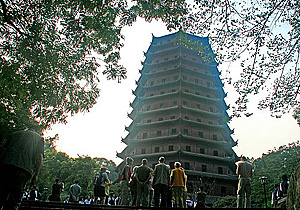Six Harmonies Pagoda

Six Harmonies Pagoda (Liuhe Pagoda) stands on Yuelun hill on the bank of the Qiantang River. Originally constructed in 970 by the King of Wuyue, the pagoda was built in the Buddhist belief it would calm the tidal waters of the river, and also as a guidance beacon for boats.
Destroyed by war in 1121 and rebuilt around 1165 during the Southern Song Dynasty (1127-1279), the pagoda is made of brick and wood, stands 60 meters tall, and has eight sides and seven stories. Exterior alterations such as adding eaves were made during the Ming (1368-1644) and Qing (1644 -1911) Dynasties. The nearby Six Harmonies Temple gave the pagoda its name which comes from the six Buddhist harmonies of Heaven, Earth, north, south, east and west.
Inside there is a spiral staircase going to the top. As you climb you can admire the carvings and paintwork of people, animals, birds and flowers that adorn each levels ceiling. From the top floor your can witness an amazing view over the Qiantang River and the beautiful surrounding scenery, though you may be there on a foggy day which will cover it. In this case you will have to swap for a mystical misty image of the ancient pagoda standing among the trees and hills.
Nearby there is a park with models of many of China's other pagodas so you can see and compare the different types and styles. Six Harmonies Pagoda is one of the most impressive pagodas in China and a true symbol of ancient architecture.